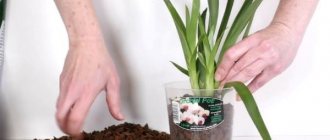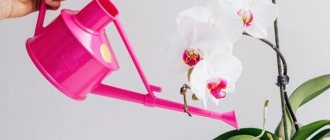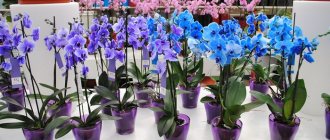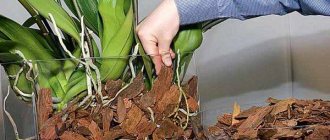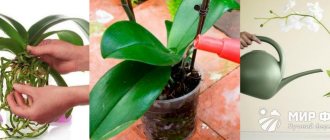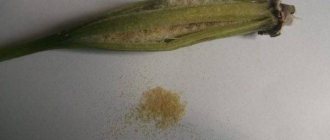The orchid has long become a regular on window sills and flower beds in Russian apartments.
However, caring for a tropical beauty is still surrounded by many myths. Dear readers!
For you, we have created communities on social networks in which useful articles and interesting ideas are published several times a day! Subscribe and receive useful content in a convenient format! In today’s article we will look at what products need to be used and what to water with so that the orchid blooms quickly and effectively at home.
What liquid fertilizers do orchids need?
When choosing fertilizers for an orchid so that it blooms quickly, you should give preference to liquid formulations. The fact is that nutrients in liquid form are better absorbed by the plant.
In addition, phalaenopsis growing at home does not tolerate fertilizers in any other form. Therefore, even if you bought drugs in a different form factor, they still need to be dissolved in water.
For orchids, it is allowed to use both specialized fertilizers and universal mixtures. But there is a rule. When using universal mixtures, their concentration is reduced by at least half.
IMPORTANT! Before applying fertilizer, soak the roots of the phalaenopsis in warm, settled water.
Ecological groups of orchids
In nature, orchids occupy different layers of the forest, therefore, they have different attitudes to growing conditions - lighting, humidity, soil nutrition, which must be taken into account when growing them indoors.
There are two groups: epiphytic and terrestrial.
Epiphytes
Prominent representatives: phalaenopsis, vanda, cattleya, dendrobium.
The name “epiphytes” from Greek means “on the plant”: representatives of this group live on other plants (phorophytes), mainly on trees. They are not parasites, since they use the phorophyte only as a place of residence, support, and receive moisture from the air and precipitation. In densely populated tropics, this feature helps them avoid competition for light and soil. Epiphytes, in addition to orchids, include mosses, lichens, and bromeliads.
Epiphytic orchids have free, photosynthetic roots, so they are grown in hanging baskets or clear glass pots.
Plants have little demand for soil nutrition. To provide all the necessary elements, it is enough to add special complex compounds.
Terrestrial orchids
Cymbidium, ludisia, bletilla, playone, and calantha growing in the lower tier of the forest receive nutrition from the rich forest litter, consisting of rotting leaves, grass, and animal excrement. Even at home, land plants require good nutrition, and some, for example, cymbidiums, even require organic matter rich in nitrogen.
Cymbidiums in nature grow both epiphytically on trees and on the ground under them.
Detailed instructions for planting different types of orchids can be found in the article on our website.
What folk remedies can you water an orchid to make it bloom?
In order to stimulate orchid flowering at home, it is not at all necessary to buy drugs in the store. It is quite possible to prepare effective fertilizers according to folk recipes.
Below are the most popular folk fertilizers that can be used to water an orchid.
Banana peel infusion
Banana peels are rich in potassium, an important element for an orchid to bloom quickly and efficiently.
The working solution is prepared at home as follows: pour one banana peel with a liter of water for 2 days. The resulting concentrate is diluted in a 1 to 1 ratio with clean water.
Water the flower with the working solution.
Potato decoction
The water left over from boiling potatoes contains potassium, phosphorus, and starch.
To enhance the effectiveness of the liquid, you can add a spoonful of sugar to it. Based on 1 tbsp. spoon for 2 liters of broth.
IMPORTANT! Before watering, the working solution must be cooled!
Onion broth
An infusion of onion peels is prepared as follows: pour a handful of onion peels into 3 liters of water. The mixture is boiled and allowed to brew for half a day.
The working solution is prepared in a ratio of 1 to 3.
Ash infusion
Ash is one of the best organic fertilizers that you can water your orchid at home.
The working solution is prepared as follows: 200 grams of ash are mixed with a liter of water and infused for 24 hours.
Before watering the orchid, the solution must be filtered through cheesecloth.
Congee
The water obtained after cooking rice is rich in beneficial substances that phalaenopsis needs. The main thing is to remember to cool the liquid so as not to damage the roots.
What ready-made liquid fertilizers for watering promote orchid flowering?
If you don’t want to bother with preparing nutritional mixtures yourself, you can purchase ready-made options.
Dr. Foley Orchid
This drug is used for foliar treatment of plants at home. Stimulates bud formation. Also, Dr. Foley Orchid is a very effective remedy for chlorosis.
Bona Forte
Stimulates the formation of flower stalks.
It has a balanced composition, most suitable for orchids. In addition to beneficial micronutrients, it contains vitamins necessary for immunity and improved photosynthesis.
Brexil Combi
Eliminates iron deficiency. Used for spraying. It is necessary to water regularly, once every three weeks.
Pokon for orchids
Complex composition suitable for year-round use. The working solution is prepared from 5 ml of the drug diluted in 1 liter of water.
Agrekol
Gel-like mixture of active ingredients. Diluted in water, then used for watering every 3-7 days.
Housing and communal services Flower paradise
Domestic preparation for root feeding. Standard for preparing a working solution: 10 ml per 1 liter of water.
When is it time to fertilize
Many people make the mistake of starting to fertilize the orchid immediately after purchasing it in the store. The essence of the problem is that immediately after purchase the flower gets used to the environment and even a small amount of fertilizer can be harmful. In general, it is not recommended to feed an orchid during the flowering period.
To extend the flowering period, the orchid needs to be fertilized several weeks before the buds appear, that is, before the budding period. If you notice the appearance of a bud, the orchid can also be supported with fertilizers. Fertilizing should be completed before the flowering period, as sometimes fertilizing during the flowering period can lead to the flowers dropping.
The best time to fertilize an orchid is during its growth period. This period is characterized by the fact that the orchid begins to grow a new leaf. Fertilizers are applied at intervals of 10-14 days, sometimes more often. If leaf growth has stopped, fertilizing should also be stopped. These fertilizing can be done along with watering, but not more than once every two waterings.
For most orchids, the optimal feeding regimen is: from May to September - once a week, from February to April and from September to the end of October - once every 2 weeks. From November to January, orchids, as a rule, are not fed.
Do not fertilize your orchid after replanting or during illness. Fertilizers can burn the roots and your flower will completely wither. After transplanting, you need to refrain from fertilizing for about a month.
What fertilizers activate the kidneys
As you know, flowers appear from buds. In order for an orchid to bloom luxuriously at home, it is necessary to lay the foundations for future flowering.
This is not a one-time process; different types of nutritional mixtures will have to be added in several stages.
Let's look at them all:
- Nitrogen-containing liquid compositions. Nitrogen should be used as a nutrient during the first watering after flowering. In this case, the feeding procedure is not carried out for the next 15-20 days.
- Potassium-phosphorus liquid preparations. Used several times during the period from the appearance of the first buds to the fall of the last petals.
- Special mixtures “for orchids”. For example, from the Forte company. Such complexes contain an optimal balance of micronutrients specially selected for orchids.
Precautions for caring for an orchid
Only harm can come from fertilizing the flower immediately after transplanting it into another container. Do not fertilize sick or weakened plants . Before applying any type of fertilizer, the substrate should be pre-moistened, otherwise root burns may occur.
Spraying as a type of foliar feeding should not be carried out in sunny weather when exposed to direct sunlight. Otherwise, the dew drops will become lenses and cause burns to the leaves.
In case of incorrect actions related to fertilizing the orchid, which can even cause the death of the plant, the substrate should be urgently and abundantly rinsed with clean, cool water and the moisture should be allowed to drain completely.
When to water an orchid with fertilizers
It is not always possible to water an orchid so that it blooms.
For example, root feeding of sick specimens is prohibited. In addition, after transplantation, the plant needs to get used to its new location. Therefore, there is no need to feed the flower at this time either.
If you haven’t watered your phalaenopsis with clean water for a long time, then in this case you can’t feed it either. Otherwise, there is a high risk of burning the roots with “chemistry”.
It is also prohibited to water flowering phalaenopsis with liquid compounds. At this time, only spraying with nutrient compositions is used.
Why doesn't the plant bloom?
This plant has begun to appear more and more often on the windowsills of apartments and houses, but, unfortunately, the orchid cannot always bloom as it does in natural conditions . Sources of its complete nutrition:
- Heavily humidified air.
- The wood on which it grows.
- The soil.
As for home conditions, they differ significantly from natural ones, so an orchid may not bloom without feeding. In addition, you need a special schedule that must be strictly followed.
Watering schemes for lush orchid flowering
Watering phalaenopsis for lush flowering at home is carried out according to the following scheme:
- During the formation of the peduncle, it is necessary to water at the root every 4-7 days.
- During the dormant period, watering should be done every 15 days and very little at a time.
- After transplanting, moisten the substrate using the immersion method. The next watering should be carried out only after 2 weeks.
Algorithm for feeding an orchid so that it blooms magnificently at home:
- Step 1. A couple of days before applying the liquid product, water with clean water.
- Step 2. Prepare the working solution according to the instructions. If you use a universal remedy for flowers, then reduce the dosage by half.
- Step 3. Allow the solution to warm to room temperature.
- Step 4. Pour the composition into a container.
- Step 5. Place the orchid pot in this container for a quarter of an hour.
- Step 6. Take out the flower and let the bottom dry, then return it to its place.
How to extend the life of a bouquet of orchids
If the flowers were brought from the store, then their cuts need to be updated. The stems should be cut at an angle. It is recommended to carry out the procedure under running water. It is advisable to update sections every 2-3 days.
The water for keeping cut orchids should be soft and clean: you can use boiled or filtered water. It needs to be updated periodically by adding fresh water.
Cut orchids, as well as potted home orchids, are afraid of too high and very low temperatures. It is also recommended to protect them from drafts and bright sun.
May your orchids always be healthy and often delight you with their blooms!
Is it possible to feed a blooming orchid?
Every gardener wants an orchid to bloom at home for as long as possible. Accordingly, the question arises, is it possible to feed a flowering plant?
In short, yes.
But there are certain nuances and rules, the observance of which will help prolong the flowering of phalaenopsis.
Firstly, you should only fertilize using the foliar method!
Secondly, when the plant produces a peduncle and buds begin to form on it, the flower can be fed with a liquid mixture of potassium and phosphorus.
Thirdly, when the flowers themselves appear, potassium preparations must be used. They will help maintain flowering for as long as possible.
REFERENCE. It is impossible to water with preparations, as the plant will redirect its forces from flowering to the absorption of fertilizers.
How to make sure there are always flowers on a plant?
Feeding an orchid is a responsible process that requires exceptional attention and compliance with the appropriate set of rules. The list of these rules is quite simple and is common to almost all types of plants.
- The orchid must be thoroughly washed before fertilizer is added to its soil.
- The mineral cocktail chosen for feeding should be properly diluted with water. Measles feeding requires one and a half liters of water per 5 ml of fertilizer, foliar feeding - three liters of water per 5 ml of fertilizer.
- The plant is fed only with liquid fertilizer, by spraying or watering.
- It is necessary to ensure that the soil is not over-moistened with water during fertilizing.
- After applying fertilizer to the roots or the plant itself (depending on the product chosen), you need to wait until the excess water evaporates, and then return the orchid to its usual place.
Important! If you have any doubts regarding the amount of feeding, you should remember that it is better to slightly “underfeed” the epiphyte than vice versa.
With proper and thoughtful care, an orchid can bloom twice a year. It is strictly forbidden to overuse fertilizing or watering the plant, as this can lead to the death of the root system. It is necessary to feed the orchid exclusively during growth, so that the root system and flowering are stimulated.
Common mistakes
- High concentration of active ingredient in universal fertilizer.
- Too frequent use of fertilizers. You should follow the watering schedule so as not to “overfeed” the plant.
- Storing the diluted working solution. The orchid should be watered with the prepared mixture immediately, since the composition loses its effectiveness during storage.
- Feeding a flower that has not been watered for a long time. The roots have dried out, and fertilizing can burn them.
- An orchid that was already blooming when it was purchased at the store is fed.
What should be included?
Orchids require a certain set of nutrients for normal development. The flower needs the following microelements:
- nitrogen – for foliage growth;
- potassium and phosphorus – for the formation of kidneys and increased immunity;
- magnesium and boron - for normal absorption of the previous components.
They also help improve metabolic processes and improve photosynthesis. As a result, the plant develops healthy leaves and lush inflorescences.
Interesting! Potassium helps accumulate moisture in orchid cells. And when it is deficient, plants experience a disturbance in nitrogen and carbohydrate metabolism.
The best store-bought drugs and fertilizers
The best store-bought preparations and fertilizers for feeding orchids must be liquid. Let's look at the main products that will be useful for plants. A special feature of the preparations is the content of macro- and microelements necessary for flowers, including nitrogen, phosphorus and potassium, which ensure the growth and flowering of plants.
| Product name | Description of the drug |
| "Kemira Lux" | Most often, the product is sold in the form of powder or granules. For one liter of water you need 1/3 of a sachet. Before watering, you need to take half a glass of the solution and dilute it with a liter of water (preferably settled), and then carry out the feeding procedure. |
| Substral | An excellent product designed for root feeding. 1 milliliter of the drug per two liters of water is enough. |
| Etisso | The product is very strong and effective. Instructions for diluting with water are given on the packaging. Users claim that it is best to dilute the products twice as weakly as written in the instructions. |
| "Master" | The drug is complex and very effective. Its composition is impressive in its variety of micro- and macroelements, and it is also rich in growth stimulants and amino acids, which are perfectly absorbed by the plant. The product is designed for feeding “at the root” and is suitable for literally all plant varieties. |
| Greenworld | It is worth diluting the products twice as weakly as indicated in the instructions. The product is intended for feeding “at the root” before watering. At the same time, drops of fertilizer should not be allowed to fall on the leaves, so as not to harm them. |
| Compo | The fertilizer is universal and suitable for all varieties of orchids, promoting growth and long-term flowering. The product is manufactured in Germany and is usually available in 500 ml containers. |
| "Flower heaven" | The composition of the product is represented by mineral compounds that are necessary not only for orchids, but also for other flowering plants. The drug is fast-acting. The dosage assumes that 5 milliliters of product are needed for 500 milliliters of water. |
| "Fasco" | This is both fertilizer and soil, which ensure active growth of the plant. Users also note a more active appearance of flower stalks. |
| "Pokon" | A strong drug that is diluted taking into account the fact that five milliliters of the product is enough for one liter of water. Feeding is carried out “at the root”. |
| Bona Forte | A good product that contains nitrogen, phosphorus, potassium, iron, cobalt, copper, magnesium and other microelements that are required for abundant flowering and growth. The product can be found in stores in different forms. For orchids, you need to choose a liquid one, and dilute it twice as weakly as recommended according to the instructions. |
| "Joy" | The fertilizer is specially created for orchids. With regular use, you can accelerate the growth of the plant and achieve abundant flowering. "Joy" is perfectly absorbed by the roots of the plant. A huge advantage is the absence of chlorine in the composition, which is harmful to orchids. |
| "Agricola" | This is a complex fertilizer containing the necessary humic substances and mineral compounds. The product was created for feeding “at the root”. |
| "Biomaster" | This product contains both mineral and organic fertilizers. With regular use, you can increase the plant's immunity to diseases. As a result, orchids will take root better after transplantation, be resistant to environmental factors, and bloom for a long time. A useful remedy for plant children. |
| "Ideal" | This is a universal liquid fertilizer that is used for both the roots and leaves of the plant. With regular feeding, you can enjoy abundant and long flowering. The product must be poured using a bottle cap. One such measuring cup is diluted in one liter of water for feeding “at the root”. And to feed the plant “leaf by leaf”, you need to dilute half a cap in one liter of liquid. |
| "Effect" | The product can be used for both root and foliar feeding. The drug is sold in liquid form in plastic bottles of 300 milliliters. The “effect” helps to increase the plant’s resistance to diseases, and it also helps saturate the plant with nutrients. |
| "Osmocote" | This is the only non-liquid fertilizer that is suitable for orchids. The product is sold in granules, which are introduced into the substrate (soil) where the orchid grows. Under the influence of watering, the granules will slowly decompose, and the nutrients will be absorbed by the roots and then transferred to other parts of the plant. |
| Japanese blue fertilizer | This is a drug with a balanced composition containing bioactive and nutrients. The product is useful for plant growth, long flowering, and strengthening the plant’s immune system. |
| "Oasis" | The product is very concentrated. It is designed for phalaenopsis, which can be processed both “by the root” and “by the leaf”. |
| "The Power of Life" | The tool is complex. It contains organic substances, vitamins and microelements important for the plant. The main advantage of the product is to enhance the color of the petals and increase the number of buds and flower stalks. The drug also enhances the plant’s resistance to diseases and pests. |
In addition, you can choose other high-quality preparations: “Garden of Miracles”, “Biohumus”, “Biopon”, “Multiflora Aqua”, “Zircon”, “Rainbow”, “Fitosporin”.
Ways to solve the problem
The nutrition of any plant should be rational and balanced. It is advisable to buy a fertilizer that is suitable for epiphytes. Necessary chemical elements for flowering:
- Potassium . Serves to ensure normal metabolism in the plant. In addition, it is responsible for immunity and photosynthesis. It is in the summer, when the flower is most vulnerable to pests, that such fertilizers are used.
- Phosphorus . Stimulates the blooming of flowers and the formation of peduncles. The plant needs this substance in the fall, when flower buds form.
- Nitrogen is necessary for the plant to grow leaves, as well as their proper development. The life of a flower depends on the area of foliage. If the area becomes smaller, it dies. This substance is necessary for the orchid in the spring, when there is a period of intensive leaf growth.
- Microelements - boron, zinc, manganese, cobalt, molybdenum, silicon, etc.
These substances are found in various fertilizers, but the whole point is still in their percentage.
Features of an indoor orchid
The peculiarity of the orchid is that it is grown in specialized soil , which consists mainly of bark, cut into fractions of 1x1 cm.
Orchids are grown in pine bark.
That is, when watering, moisture practically does not remain in the soil. But there are very few of these minerals found in orchid soil, which means that during flowering and immediately after it, it will need specialized nutrition to restore its strength.
IMPORTANT! Timely feeding with the necessary mineral cocktail will be the key to good growth and excellent appearance of the plant.
Watering: the golden mean
In nature, orchids grow in places with very high humidity. Therefore, at home you need to ensure that the substrate, and therefore the roots, is always saturated with moisture. But remember that overwatering can lead to rotting of the roots. It is generally believed that weekly abundant watering is quite sufficient, with the exception of hot periods (temperatures above 25 C°). Place the pot in a bucket of water for 30 minutes so that the water level is no higher than the rim of the pot. Water should not get on the young shoots of the plant. In addition, you can spray the surface of the substrate, and sometimes the leaves, with a spray bottle if it is very hot. The exception is miltonia; its leaves become stained after water gets on them. Water for irrigation should be at room temperature and without calcium. Only Paphiopedilum likes slightly calcined water.
Air humidity. To maintain the air humidity necessary for orchids at home, you can place a home fountain next to the plant and use a humidifier. Or the simplest option is to place a container of water next to the plant.
